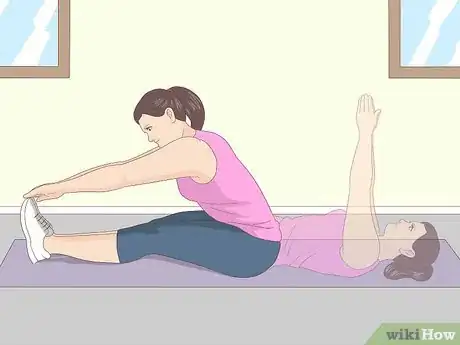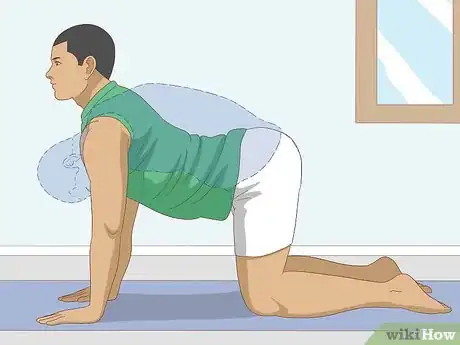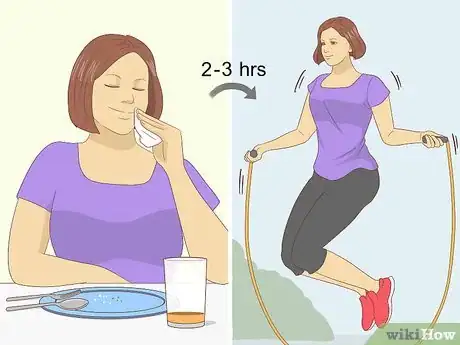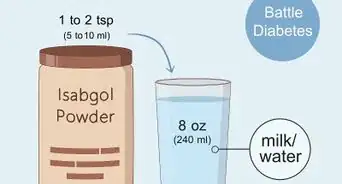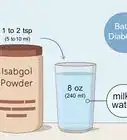This article was co-authored by Julian Arana, M.S.eD., NCSF-CPT. Julian Arana is a Personal Trainer and the Founder of B-Fit Training Studios, a personal training and wellness set of studios based in Miami, Florida. Julian has over 12 years of personal training and coaching experience. He is a certified personal trainer (CPT) by the National Council on Strength and Fitness (NCSF). He has a BS in Exercise Physiology from Florida International University and an MS in Exercise Physiology specializing in strength and conditioning from the University of Miami.
There are 13 references cited in this article, which can be found at the bottom of the page.
This article has been viewed 23,525 times.
Ugh, we’ve all been there—eating so much you feel bloated and like you can’t move. You may even undo a pants button or two to get a little extra breathing room. But, don’t worry. You can actually help boost your digestion with a few specific exercises. Just make sure you aren’t exercising on a full stomach or it could lead to indigestion. Healthy exercise and digestion go hand in hand, so work on developing healthy habits that can help prevent gas, bloating, and indigestion in the future.
Steps
Specific Exercises
-
1Walking: Take a 15-minute walk after a meal to help aid digestion by stimulating peristalsis, which is the process of moving food through your digestive system. Research also suggests that a short post-meal walk can help lower blood sugar. Walk on a treadmill or around your neighborhood to get some fresh air.[1]
- Italians have been walking after meals for centuries. Looks like they were on to something!
-
2Jump rope skips: Jump rope is a great cardio exercise that will help improve your digestion. Grab a jump rope that fits you (it should reach your shoulders when it’s folded in half), and shoot for about 15 minutes of skips.[2]
- If you’re new to jump rope, don’t be afraid to take breaks if you need a rest!
- Cardio exercises get your heart rate up and are one of the best ways to boost your digestion.
Advertisement -
3Full-body roll-ups: Lie down flat on the ground or on a yoga mat. Take a deep breath and raise your arms up so they’re perpendicular to the floor. Breathe out and sit all the way up. When you’re sitting up, reach up overhead and lean forward to reach toward your toes. Then, slowly roll back down until you’re lying flat on the ground in the starting position. Use this exercise to work your core and help boost your digestion.[3]
- Focus on your breathing while you perform the exercise.
- Shoot for 10 reps of this movement.
-
4Avoid high-intensity exercises and weight lifting. Sprinting, gymnastics, weight lifting, and other intense forms of exercise can cause indigestion and acid reflux, so steer clear of them if you’re having digestion problems. Stick with moderate to low impact exercises like walking, light jogging, and jump rope to help improve your digestion.[4]
Stretches
-
1Seated forward folds: Take a seated position on the floor or on a yoga mat. Take a breath and lift both arms up over your head. Exhale and lean forward, bringing your nose to your knees. Reach your arms as far forward as you can. Hold the position for 3 breaths and then unfold and return to the starting position to massage your abdominal region and improve digestion.[5]
- Repeat the movement 3 times to help stimulate your entire abdominal and pelvic region.
-
2Crescent lunge with a twist: Stand up tall, take a big step forward with 1 leg, bend your knees, and sink your hips down so you’re in a stable lunch position. Bring your palms together in front of your chest. Then, rotate your upper body towards your bent leg and rest your elbow on your bent leg. Hold the twist for 3-4 breaths, then slowly release it and return to the starting position. Repeat the exercise on the other leg to improve blood flow in your abdominal region.[6]
- Aim for 2-3 reps on each leg.
- When you’re in the twisted position, blood flow is temporarily cut off to your abdominal region. When you return to the normal position, the increased blood flow can help improve digestion.
-
3Bellows pose: Lie flat on your back and take a big breath as you raise your arms above your head. Exhale and bring your right knee to your chest. Interlace your fingers and hug your knee to your chest for 3 breaths. Then, release your knee and return to the starting position. Repeat the movement with your other leg.[7]
- Do the exercise 3 times on each leg to help relieve gas, constipation, and indigestion.
-
4Cat-cow: Get down on your hands and knees so your hands are even with your shoulders and your knees are even with your hips. Keep your back nice and flat. Exhale and round your back up as much as you can to do a cat stretch. Then, take a big breath as you drop your spine and open up your chest to do a cow stretch. Alternate back and forth between cat and cow for 10 breaths to flex and relax your ab muscles, which can help with digestion.[8]
- The action of your breathing and activating your diaphragm boosts your oxygen levels and helps with digestion.
-
5Child’s pose: Kneel down so your knees are open and your toes are touching. Bend your body forward so your forehead is resting on the floor. Stretch your arms above your head and allow your stomach to relax as you take 10 breaths in the position to help boost digestion.[9]
- Use this pose to finish your exercise.
- After your 10 breaths, you should feel better and more relaxed.
Healthy Habits
-
1Wait 2-3 hours after a meal before you exercise. A large meal can delay your digestion so give your body some time to process your meal before you get active. Wait at least 2 hours after a meal and try not to eat too much if you know you’re going to exercise afterward.[10]
- Stick with fast-digesting foods such as high-carb, low-fat foods if you plan to exercise after you eat.
- Avoid eating a ton of protein and high-fiber food before you workout, which takes longer to digest.
-
2Try to exercise 3-4 times a week to keep your digestive system healthy. Regular exercise can help improve your digestive health overall. If you can, try to exercise on a daily basis, or at least several times a week.[11]
- Find exercises and activities that you enjoy doing so you'll be more likely to stick to a routine. For instance, if you enjoy cycling but you really don’t like running or lifting weights, no problem! You can stick to biking.[12]
- Come up with an exercise schedule that works for you and your schedule so it’s easier to stick to.
-
3Eat a balanced, healthy diet. It might seem like a no-brainer, but what you eat can make a big difference in your digestive health.[13] Focus on eating whole grains, lean proteins, and healthy fats.
- Steer clear of processed or junk food.
- Try to limit the amount of sugar that you consume.
-
4Stay hydrated while you exercise. Make sure you drink enough water to replace any fluids you lose from sweating. Try to drink 17–20 fluid ounces (500–590 mL) of fluid about 2-3 hours before you exercise and another 8 fluid ounces (240 mL) about 20-30 minutes before you start exercising. While you exercise, try to consume 7–10 fluid ounces (210–300 mL) every 10-20 minutes. About 30 minutes after you’re done exercising, drink another 8 fluid ounces (240 mL).[14]
- Dehydration can lead to exercise-related gastrointestinal problems such as constipation, acid reflux, and other digestive issues.[15]
-
5Quit smoking to improve your digestive health. Smoking can negatively affect your digestion. If you smoke, try quitting as soon as you can. You’ll improve your digestive and overall health.[16]
Expert Q&A
Did you know you can get expert answers for this article?
Unlock expert answers by supporting wikiHow
-
QuestionHow can I get motivated to exercise?
 Julian Arana, M.S.eD., NCSF-CPTJulian Arana is a Personal Trainer and the Founder of B-Fit Training Studios, a personal training and wellness set of studios based in Miami, Florida. Julian has over 12 years of personal training and coaching experience. He is a certified personal trainer (CPT) by the National Council on Strength and Fitness (NCSF). He has a BS in Exercise Physiology from Florida International University and an MS in Exercise Physiology specializing in strength and conditioning from the University of Miami.
Julian Arana, M.S.eD., NCSF-CPTJulian Arana is a Personal Trainer and the Founder of B-Fit Training Studios, a personal training and wellness set of studios based in Miami, Florida. Julian has over 12 years of personal training and coaching experience. He is a certified personal trainer (CPT) by the National Council on Strength and Fitness (NCSF). He has a BS in Exercise Physiology from Florida International University and an MS in Exercise Physiology specializing in strength and conditioning from the University of Miami.
Certified Personal Trainer
Warnings
- Some gastrointestinal conditions can be affected by exercise. If you have a condition such as IBS, GERD, ulcer disease, IBD, diverticular disease, or any other condition, check with your doctor before you start a new exercise routine to make sure it’s safe for you.[18]⧼thumbs_response⧽
References
- ↑ https://time.com/5405778/walking-after-eating-good-for-you/
- ↑ https://youtu.be/GrNgpEgQUKg?t=19
- ↑ https://youtu.be/GrNgpEgQUKg?t=68
- ↑ https://dighealth.org/blog/how-exercising-can-relieve-your-acid-reflux/
- ↑ https://www.goodhousekeeping.com/uk/health/healthy-eating/a558368/easy-stretches-that-help-digestion/
- ↑ https://youtu.be/GrNgpEgQUKg?t=96
- ↑ https://www.goodhousekeeping.com/uk/health/healthy-eating/a558368/easy-stretches-that-help-digestion/
- ↑ https://youtu.be/GrNgpEgQUKg?t=33
- ↑ https://youtu.be/GrNgpEgQUKg?t=127
- ↑ https://www.manhattangastroenterology.com/exercise-affects-digestion/
- ↑ https://www.health.harvard.edu/topics/digestive-health
- ↑ [v161341_b03]. 19 May 2019.
- ↑ https://www.health.harvard.edu/topics/digestive-health
- ↑ https://health.usnews.com/wellness/articles/2018-07-09/how-much-you-really-need-to-drink-when-exercising
- ↑ https://www.manhattangastroenterology.com/exercise-affects-digestion/
- ↑ https://www.health.harvard.edu/topics/digestive-health
- ↑ https://www.manhattangastroenterology.com/exercise-affects-digestion/
- ↑ https://badgut.org/information-centre/a-z-digestive-topics/physical-activity-and-gi-health/


